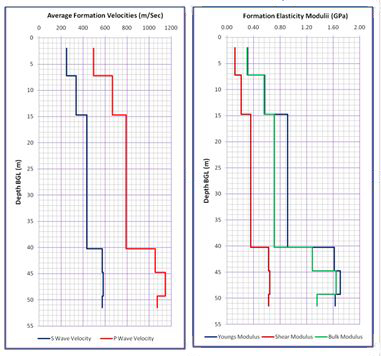The Seismic Cross Hole Survey yields detailed measurements of in-situ compressional and shear wave velocities in cased boreholes typically spaced 3 to 6 m apart. The Cross-Hole survey provides information pertinent to the seismic wave velocities of the material in question. These velocities are used as input into site specific static / dynamic analyses, or for computing Shear Modulus, Young’s Modulus, and Poisson Ratio for material characterization or for determination of vertical and lateral heterogeneity existing at site.
Seismic Cross Hole tomography survey uses two or more boreholes to measure wave propagation velocities along horizontal paths. The simplest Cross Hole Tomography survey configuration consists of two boreholes, one of which contains an impulsive energy source and the other a receiver. By fixing both the source and the receiver at the same depth in each borehole, the wave propagation velocity of the material between the boreholes at that depth is measured. By testing at various depths, a velocity profile can be obtained. When possible, use of more than two boreholes is desirable to minimize possible inaccuracies resulting from trigger time measurement, casing and backfill (material placed between the casing and the borehole wall) effects, and site anisotropy.
The Cross-Hole survey often allows individual soil layers to be tested since layer boundaries are frequently nearly horizontal. It can also detect hidden layers than can be missed by Seismic Refraction surveys. Cross-Hole surveys can yield reliable velocity data up to depths of 50 to 60 m using mechanical impulse sources.
We have been conducting Cross-Hole surveys up to 150 m depth, with one source and 2, 3 or 4 receiver boreholes configurations.
The Company provides the following services using Seismic Cross-Hole survey for various engineering and environmental projects:
- Evaluation of lateral and vertical material continuity
- Profiling of in-situ seismic (P & S) wave velocities
- Liquefaction analyses, deformation studies, and investigations concerning amplification and attenuation of ground motion
The Company follows ASTM International Standard Designation D4428 / D4428M-14 Guide in acquisition, processing and interpretation of Cross-Hole Survey data.

